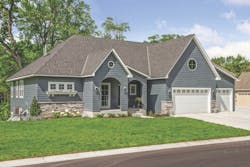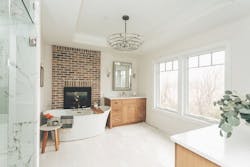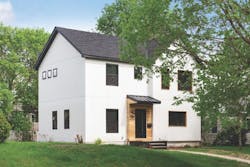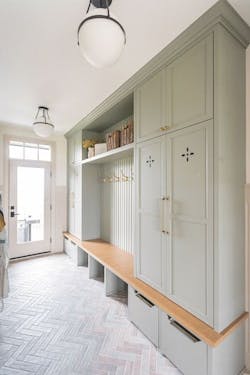Backstory: Textbook Case of Student Becoming Design/Build Owner
Kirsten Erickson was never one to give up—not even in the eighth grade when a boy was chosen over her to shadow an architect for their school career day. She was plotting her future. In fact, Erickson has been plotting since she was 6 years old and her parents hired a contractor to build them a home. She would wander through the site imagining her new bedroom. “I decided home building was the coolest thing ever,” she says.
Erickson’s journey is one of deliberation and careful choices that eventually led her to founding Alma Homes, a design/build firm in Orono, Minn.
Absorbing Knowledge
Unlike many in the building industry, Erickson did not come from a family of tinkerers and builders. “Construction was not something in my blood,” she says.
But she always loved math and art. In middle school, she’d been given a computer game similar to “The Sims” with which she could build a virtual house. At the time, her parents were talking about building a cabin and Erickson says she spent “the entire summer designing a million options for it. I played it every free moment.” The cabin didn’t come to fruition, and her parents chose to have a home built instead. “For several years, that was the daily dinner talk,” Erickson says. “I was heavily involved in that process. Creating floor plans felt like a giant puzzle to solve.”
“What’s more relaxing than sitting in a tub next to a fire?” asks Alma Homes founder and owner Kirsten Erickson (top). The double-sided fireplace can be enjoyed from the bedroom and the bath (Photos: Chelsie Lopez Productions).
In 2006, she began studying architecture at the University of Minnesota, minoring in construction management and housing studies. “I was wise enough to know that I didn’t know a lot when it came to construction, but I loved learning.” She headed off to graduate school in architecture at the University of Colorado, graduated, stayed on, and followed that up with an MBA, she says, “knowing that my goal was to own my own architecture firm.”
In 2013, Erickson landed, with all of her knowledge, in a soft market. A friend who worked for a larger custom home builder let her know there was an opening for an interior designer. She took it. “It wasn’t my first choice,” she says, “but they had an architecture department and I thought, ‘It’s a job, it’s in residential, it’s a foot in the door with a big company, and maybe I’ll get exposure to the architecture side.’”
In this whole-house remodel, Alma Homes took a single-story 1950s home down to the studs, added a second level, and modernized (Photo: Spacecrafting Photography).
A self-described “giant sponge” when it comes to learning, Erickson is glad she took the job. It exposed her to interior design and the construction industry in practice. It helped her see that her career could be more than just owning an architecture firm. “I fell in love with the custom home building process, with design/build. And I loved the collaboration with project managers and those in the field.” She stayed with the firm for three years.
Erickson also had begun buying, renovating, and flipping homes on her own during and just after graduate school. She kept the profits in reserve, knowing she could use the money when it came time to start her business. Just when she was about to take that leap, a large production builder in Minnesota made her an offer she says she couldn’t refuse, and she became their director of design.
Again, she spent a year learning all she could. “They had great processes,” Erickson says, “and helped me implement a custom mindset on a production scale.”
In 2017, Erickson felt she had the knowledge and the cash. She wouldn’t have to take out a business loan. “I had enough money that I could fail for an entire year and not make a dollar and still feel fine financially,” she says. She also had good relationships with a network of subcontractors she’d worked with over the years.
Small and Selective
When Erickson was flipping houses, she’d gotten into using social media, particularly Instagram, which was relatively new at the time. She gained a following and nourished the relationships she’d established. “When I started Alma,” she says, “I had a portfolio I could present to say, ‘Here’s what I’m capable of.’”
Followers who weren’t yet ready to build came back to her when they were. “For two years I showed up in their feed every day,” Erickson says. “[It’s like] there’s a level of trust that’s already established. That was really helpful for us.”
Erickson describes her custom designs as “clean, light, and bright —‘livable elegance.’ I don’t want them to be stuffy and ostentatious. When people come through our homes, they say the houses feel cozy and homey.”
According to Erickson’s design philosophy, spaces should be beautiful as well as functional, as this mudroom shows (Photo: Chelsie Lopez Productions).
To make her homes inviting, Erickson uses a lot of light colors to keep the spaces feeling airy but pairs that palette with natural textures and wood tones. She might choose warm wood tones for the floor and wooden accents in cabinets, shelves, or millwork details. Instead of doing big, open floor plans, she says, “a lot of our plans have more defined spaces, so the rooms don’t feel large or empty. We also love centering our designs around fireplaces whenever possible. People will tell me our homes feel inviting and they feel like they could actually see themselves living there.”
Because Erickson’s clients know her style and have vetted her on social media and her website, they come to her with like minds. But, Erickson points out, “I don’t force my design ideals on clients. I like to bring out their personalities and their designs. It’s a good marriage.” Alma Homes builds a wide range of styles—contemporary, farmhouse, cottage—which Erickson says keeps the firm on its toes.
The company now has five full-time employees (an architect/designer, interior designer, two project managers, and a content creator for marketing) and subcontracts labor. They do between 10 and 15 projects each year, ranging in cost from $300,000 whole-house remodels to $750,000 and up for new construction.
And Erickson is determined to remain small. “We don’t ever want to be a massive builder. I want to work with clients who feel like family,” she says. “Our motto internally is, ‘If I wouldn’t have them over for dinner, they’re not a right fit for us.’”
Stacey Freed covers design and the built world from her home in New York state.




